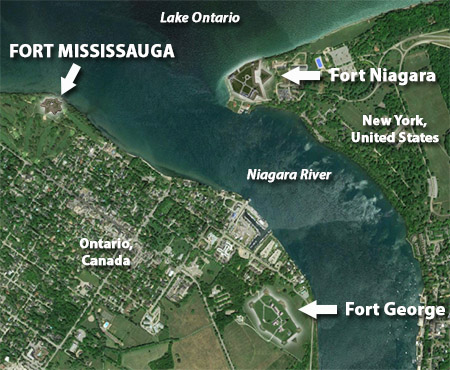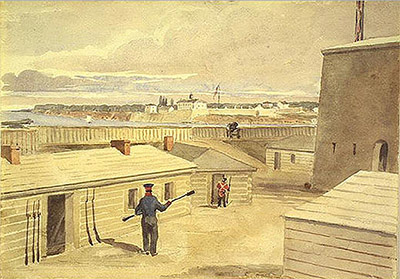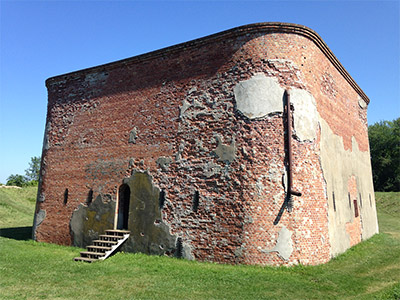EPISODE 599 FORT MISSISSAUGA…HIDDEN AWAY ON A GOLF COURSE
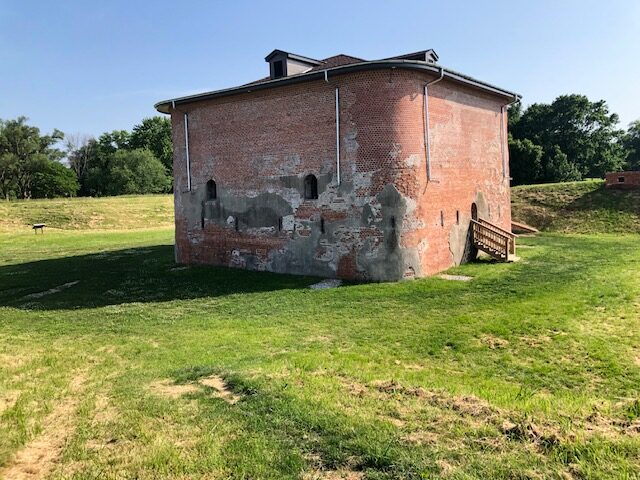
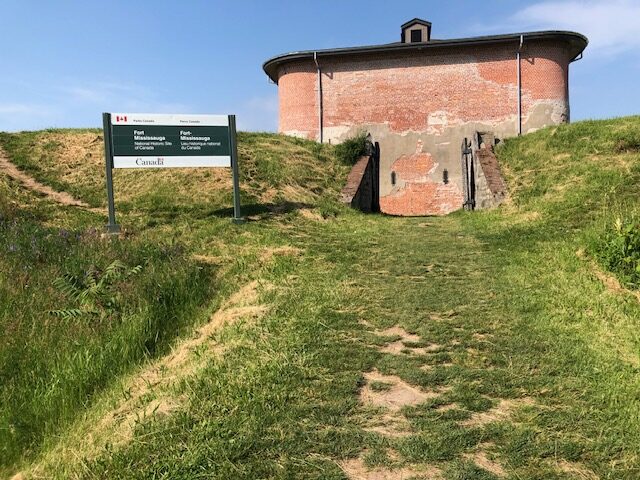


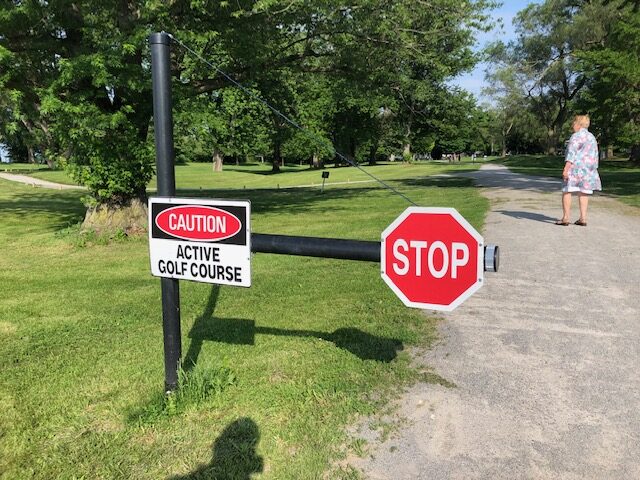
alan skeoch
June 2022

Fort Mississauga, Niagara on the Lake, Ontario, 1814-1816
“What is that huge pile of bricks?”
“That is Fort Mississauga….was intended to be huge classic Star shaped fort
but cutbacks happened after 1816.”
“Cutbacks?”
“No need. Obsolete design. Peace…unlikely would we ever go to war with the United States again.”
“No need for a large star shaped fortress anymore”
“Star shaped?”
“Easier to defend….soldiers could fire down from the points of the star
if enemies thought to try and scale the fort walls after getting by the moat.
Seemed a good idea but forts fell out of style when canons got better…able
to blast the walls to bits.”
“Do you want to know why the walls are made of dirt and gravel rather than
stone and cement?”
“Stone sounds better for a fort. Why use dirt? Probably to save money.?”
Nope, dirt walls were better than] stone. Exploding artlllery shells were muffled
in the dirt. Did less damage. At least that’s what I read somewhere.”


If Fort Mississauga was built as originally planned, it would look something like this STAR LAYOUT for forts.
“How come I’ve never heard of Fort Mississauga?”
“Not much to see…just one building which looks like a
huge pile of bricks. That’s it…a huge pile of bricks.
And earth piled up in a star shape if you look carefully. A person
needs imagination visiting Fort Mississauga.
“Huge pile of bricks”
“The black engineers who built the fort between 1814 and 1816 had
lots of bricks….great piles of them…no need for brick making.
In 1814 bricks were piled up like rubble.”
“Get serious . ALAN”
“Bricks were piled helter skelter all-around the place”
“Why?”
“Because American troops captured Newark (now Niagara on the Lake)
and set the town on fire. Fort Mississauga is made from the ruined
town….thousands of used bricks.”
“Did you say Black Engineers?”
“Thought you might have caught that word…black”
“Black British troops?”
“Yes, black Canadian troops built Fort Mississauga…they were happy to
do so into the bargain. There were issues of discrimination involved.
How to use black troops. Although they were prepared to be in the centre of action.
Some official decided to set them to work building the fort.
It still stands.. But one lonely building surrounded by a dirt all with a star profile.
Not much to see. Remember I Said you needed imagination to appreciate Fort Mississauga.

Marjorie found a golf ball just as we got near the fort.

Another remarkable thing about Fort Mississauga is that it
stands in the middle of the oldest golf course in North
America. So the fort is a little dangerous. It is possible
to get beaned by a golf ball.
Much more to say but this is enough for today
alan
Post Script: Official history of Fort Mississauga
|
Fort Mississauga
Niagara-on-the-Lake, Ontario, Canada |
||||
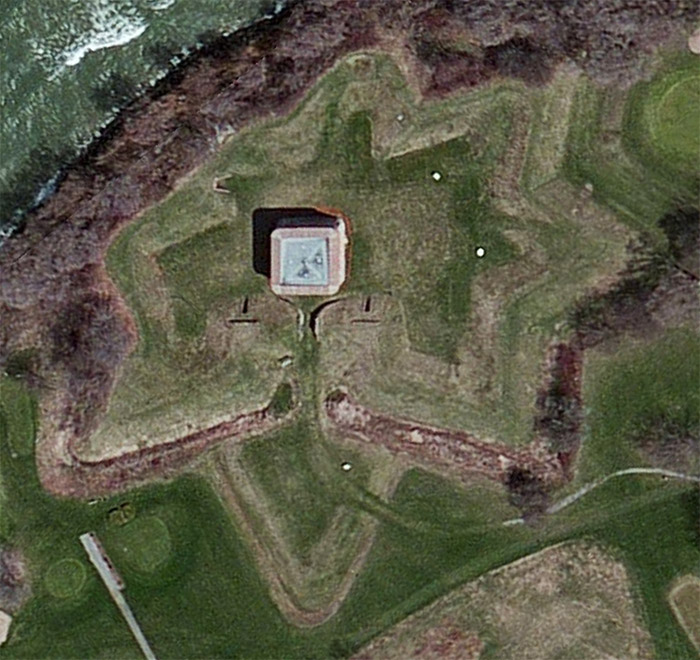 |
||||
 |
||||
|
||||
|
In the 1720’s France began work on what would become Fort Niagara, which the British took from them in 1759, during the French and Indian War (1756-1763). Though after the American Revolutionary War (1775-1783) this fort was within the boundaries of the new United States, the British lingered in Fort Niagara until 1796, when the Jay Treaty finally made it COMPLETELY CLEAR THAT THEY WOULD BE LEAVING NOW THANK YOU VERY MUCH. All of this meant that Great Britain suddenly had no defenses at the extremely important mouth of the Niagara River. Great Britain immediately got to work on Fort George, just a smidge upriver (and on the opposite bank) from Fort Niagara. Fort George was completed in 1802. Plans had been afoot to build a 14-gun battery facing Fort Niagara at Mississauga Point in 1799, but once the impressive Fort George was completed, adding more guns to this mix seemed unnecessary. Instead, the first lighthouse on the Great Lakes was built at Mississauga Point in 1804. The name Mississauga refers to the Algonquin Mississauga Indians, who were present in the area when the French first arrived in the 17th century. The word means, “those at the great river mouth,” which assumedly refers to the Niagara River where it meets Lake Ontario. |
||||
|
||||
|
The British troops that had been ejected from Fort George thanks to the excellent planning and leadership of Colonel Winfield Scott (1786-1866) scampered to Burlington Heights, a fortified position at the far western tip of Lake Ontario. While the Americans had been great at capturing Fort George, they proved less great at further endeavors inland, perhaps in part due to the fact that Winfield Scott had been wounded at the battle of Fort George, removing him from the field until later in the war. Britain was victorious at both the Battle of Stoney Creek (June 6, 1813) and the Battle of Beaver Dams (June 24, 1813), and the demoralized Americans would abandon Fort George on December 10, 1813. |
||||
|
||||
|
It seems that Boyd’s characteristic role in most tense situations was to lose control over them. True to form, just before abandoning Fort George, things got out of hand and American troops put Newark to the torch without warning anyone, dumping the town’s dazed populace into the snow. This needless destruction enraged the British, who would burn several American towns in retribution when it shortly became their turn to invade their enemy’s land and capture their starforts. |
||||
|
||||
|
Another possibility seems to be that an American brigade of 3000 men under Colonel Moses Porter (1755-1822) advanced on what must have been a diminutive Fort Mississauga in July of 1814, only to be chased away by long-range cannon fire from the fort. These two events may or may not have happened, as they are briefly described in the signage at the fort, but I cannot find mention of them elsewhere. Both Brown and Porter fought heroically at the Siege of Fort Erie in August of 1814, and these actions may have been misattributed to Fort Mississauga. The starfort of our current interest did have impressive, 20-foot thick, star-shaped earthworks by the end of 1814, along with a series of log buildings within those walls, in which the garrison spent its lonely days. Perhaps fortunately for Fort Mississauga, it was left alone for the remainder of the war. The tower was only nine feet high in 1816, but was finally completed in 1823. In 1837 and 1838, a series of rebellions broke out in Canada, led by Canadians yearning for “responsible government.” While a government reeking of responsibility was indeed created not long after these rebellions, these events nonetheless freaked Great Britain out, and Fort Mississauga’s defenses were bolstered as a result. |
||||
|
||||
|
I visited Fort Mississauga in August of 2015! If you’re interested in seeing more of how the fort looks today, perhaps you’ll visit the Fort Mississauga page in the Starforts I’ve Visited section. *The claim that Fort Mississauga is the only remaining star-shaped earthwork in Canada is made in the signing at the fort. Claims such as “biggest,” “oldest,” and “last remaining” seem to often be made locally at starforts without much in the way of research, or with a whole lot of qualifications affixed thereto. Fort Mississauga may be the only star-shaped earthwork remaining in Canada, but…Canada is a big place. Be careful with those heroic superlatives, starforts! |
||||
|
|


